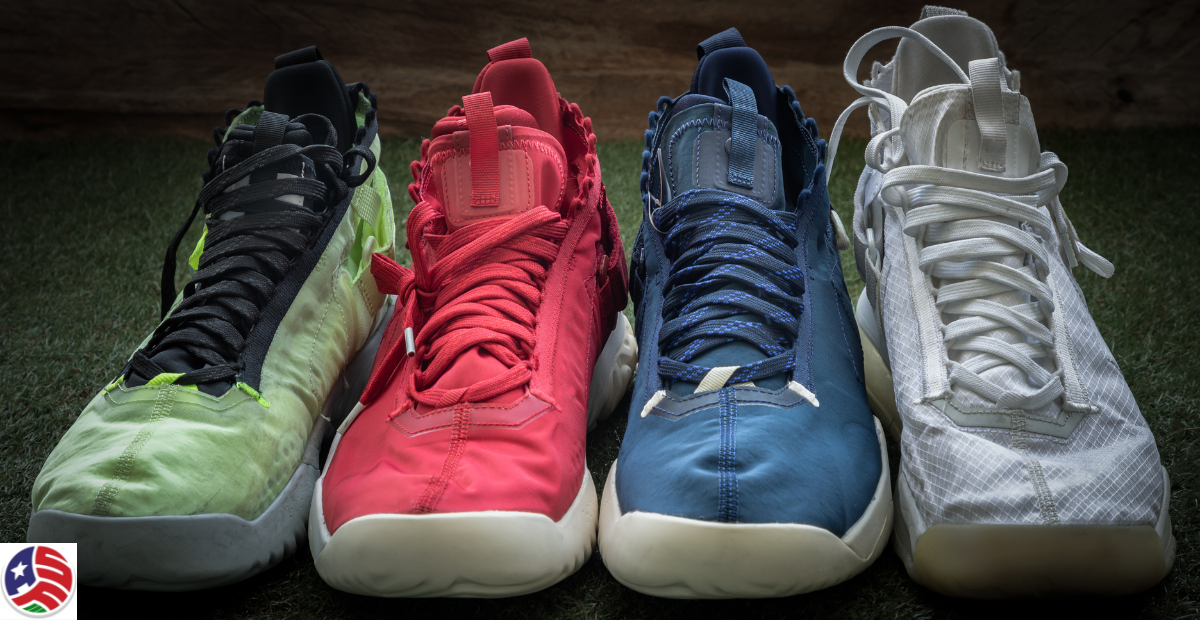Achieving the perfect basketball shoe fit is more than just a matter of comfort—it can dramatically impact your performance on the court.
Shoes that are too tight lead to blisters, restricted movement, and discomfort, while a loose fit can cause dangerous slips, reduced stability, and even injuries. The right fit ensures you stay agile and supported during every fast cut, jump, and pivot.
In this AM-FANS guide, we'll break down exactly how your basketball shoes should fit so you can maximize both comfort and performance.
Key Elements of a Proper Basketball Shoe Fit
1. Toe Box Fit
When it comes to the toe box, the fit should allow for a small amount of wiggle room but prevent significant movement. This space helps avoid toe jam during hard stops or jumps. To check, stand and press down on the front of the shoe—about a thumb's width from the longest toe to the tip is ideal.
2. Heel and Ankle Lockdown

Proper lockdown prevents heel slipping and ensures ankle support during quick cuts or pivots. Aim for a snug fit that holds the heel securely but doesn’t dig in. Padding or special lacing techniques can enhance fit.
3. Arch and Midfoot Support
The shoe should contour closely to the arch of the foot to prevent strain. Whether you have flat feet or high arches, ensuring a snug midfoot fit stabilizes the foot while reducing injury risks.
Dive deeper into fit with our complete guide to basketball shoe fit.
How Tight Is Too Tight? Common Mistakes to Avoid
Understanding the Balance in Fit
When buying basketball shoes, it’s crucial to strike the right balance between a snug fit and overall comfort. Basketball shoes that are overly tight can restrict blood flow, leading to numbness or discomfort. On the other hand, loose shoes reduce support and risk injury during quick cuts or jumps.
Signs Your Shoes Are Too Tight or Loose
- Too Tight: Pinching, hot spots, and restricted toe movement.
- Too Loose: Heel slippage, excessive foot movement, and lack of ankle support.
Adapting Your Basketball Shoes Fit to Your Playing Style
Position Matters for Optimal Fit

The ideal basketball shoes fit depends on your playing style and position. Guards benefit from a lighter, snug fit for speed and agility, while forwards and centers may prefer a more supportive fit with strong ankle protection. Your playing style dictates how snug or roomy your shoes should be, balancing responsiveness with stability.
High-Tops, Mid-Tops, and Low-Tops
High-Tops
High-top basketball shoes extend above the ankle, providing superior support and stability, which makes them a favorite for players who prioritize defense or engage in heavy rebounding and post play. The additional ankle coverage helps prevent rolling during pivots or high-impact landings. However, the extra support can come at the cost of added weight, potentially reducing speed.
Mid-Tops
Mid-tops strike a balance between mobility and support, sitting just at or slightly above the ankle. This makes them a versatile choice, catering to players with mixed roles—like guards who cut frequently but still require some ankle protection. Mid-tops maintain a solid basketball shoes fit without sacrificing too much agility.
Low-Tops
Low-tops prioritize speed and agility by allowing full range of ankle motion, making them popular among guards or players with a fast-paced, agile playing style. While they offer less ankle support, low-tops provide excellent court feel and lightweight flexibility, perfect for quick direction changes and rapid accelerations.
Looking for basketball discounts? Browse AMFANS specials.
Testing Your Basketball Sneakers for the Perfect Fit
Fit Testing Tips
Before making a purchase, it’s essential to test basketball sneakers to ensure they meet your needs. Most basketball shoes should offer a snug fit that supports your foot without cutting off circulation. To test, lace them tightly and walk, jump, and pivot as you would during a game. This helps assess heel stability, toe room, and overall comfort.
Step-by-Step Basketball Shoe Fit Testing Guide
- Thumb Space Test: With the shoes on, stand up and press your thumb down at the front. Ideally, there should be a thumb’s width of space between your longest toe and the shoe tip for optimal movement and comfort.
- Walk and Move: Take a few steps, pivot, and jump to simulate game movements. Check for heel stability, snug midfoot, and no pinching or excessive sliding.
- Flex Test: Bend the shoe to ensure it flexes naturally with your foot’s motion.
Use Game Socks for Accuracy
When testing most basketball shoes, it's crucial to wear the same type of socks you'll use during games—typically thicker, moisture-wicking athletic socks. This ensures that the basketball sneakers provide an accurate fit during high-intensity play, accounting for factors like extra cushioning, sweat absorption, and added thickness. Skipping this step can lead to a less precise fit, potentially causing discomfort or reduced performance once you’re on the court.
Tips for Choosing the Right Basketball Shoes When Shoe Shopping
Know Your Foot Type
Understanding whether you have flat feet, high arches, or a neutral arch is key to finding the right basketball shoes. Different shoe models offer varying levels of arch support and cushioning to match your specific needs.
Consider Your Play Style and Position

When shoe shopping, focus on shoes tailored to your playing style—whether you prioritize speed, defense, or all-around play. The right basketball shoes will complement your on-court movements, offering optimal support, traction, and stability.
Try Shoes Later in the Day
Feet tend to swell throughout the day, so trying on shoes in the afternoon or evening helps ensure a fit that accounts for maximum foot expansion. This way, your basketball shoes remain comfortable even after hours of intense gameplay.
What Makes Good Basketball Shoes?
Durability and Traction
Good basketball shoes are built to last through tough games and practice sessions. Look for durable outsoles made from high-quality rubber that provide excellent traction on both indoor and outdoor courts. Reliable grip helps prevent slips and supports explosive movements.
Comfort and Cushioning
A good pair of basketball shoes offers superior cushioning to absorb impact during jumps and landings. Technologies like air cushioning or foam midsoles can enhance comfort, reducing strain on the feet and joints.
Support and Fit
Good basketball shoes should offer a snug, supportive fit that stabilizes the ankle, heel, and arch without causing discomfort. Proper support helps reduce the risk of injuries and alleviates issues like foot pain, which can arise from poor arch support, excess movement, or ill-fitting designs. Shoes that fit securely and hold your foot in place prevent excessive strain during high-intensity play, reducing potential pain and promoting better on-court performance.
Frequently Asked Questions (FAQs)
Can basketball shoes be stretched out?

Yes, over time basketball shoes may stretch slightly due to wear. Breaking them in gradually through regular activity helps them mold to your foot shape.
What should I do if my basketball shoes cause foot pain?
If foot pain occurs, check for arch support and fit issues. Consider adding insoles or choosing shoes with better cushioning and support for your foot type.
Is it okay to wear thick socks with basketball shoes?
Wearing thick, moisture-wicking socks can enhance comfort and fit. Be sure to test the shoes with game socks to avoid tightness.
How do I know when to replace my basketball shoes?
Replace shoes when you notice significant wear on the sole, decreased cushioning, or reduced support, as these can impact performance and increase injury risk.




